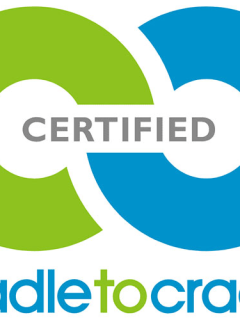Food packaging is the container for food: it is in direct contact with the food and must not present any health hazard. Trays, bowls, bags… Food packaging can take different forms and be made of different materials.
But what exactly is the role of food packaging? Find out all the functions of packaging and the regulations on this subject in the food sector in this article.
Food packaging, a packaging with multiple roles
Food packaging is packaging designed to contain food temporarily. Its role is toisolate the product from the external environment, to protect it from possible pathogens or shocks during transport, to preserve it and to enhance its value .
Food packaging must also be easy to use and provide information on the product (conservation, composition, use-by date, etc.). It must be suitable for food contact, meeting a number of standards. To this end, food packaging must be free of harmful substances and not have an impact on the taste, smell or appearance of the food contained.
Food safety, a major challenge for food packaging
First and foremost, food packaging must be safe for the consumer. It must be “food grade”.
What is food grade packaging?
Food-grade material can safely contain foodstuffs. Food contact packaging doesnot release flavours, odours or harmful substances into the food it contains. In other words, it does not spoil the products.
If substances or materials are transferred to the foodstuffs, the phenomenon is called “migration”. Food quality is therefore subject to standards, including a migration threshold that must not be exceeded.
What does compliance testing of food packaging involve?
The food safety of packaging can be verified by independent, commissioned service providers and institutes. They are responsible forchecking the compliance of food packaging with legal requirements. The EC Regulation 1935/2004 sets out the general requirements for materials intended to come into contact with food.
Plastic, cardboard, paper, aluminium, glass… All these materials must be tested for food compliance when they are intended for this sector. When testing for food compliance ,the migration of certain substances into the product is measured. For example, when testing plastics, two concepts are differentiated:
- The overall migration Overall migration: the total amount of chemical substances allowed to migrate into a food product is measured. The EU Regulation 10/2011 sets the limit value at 10 mg/dm² or 60 mg/kg.
- The specific migration The migration of defined substances in a food is measured. The same regulation specifies a maximum value that must not be exceeded for certain substances. The specific migration is expressed in mg/kg of the food.
Following these migration tests, a declaration of conformity can be made, provided that the food packaging complies with the regulation.
What is the food compliance symbol?
In the European Union, the food conformity of a food is indicated by a symbol consisting of a glass and a fork. This ensures that it is suitable for contact with foodstuffs, without deviating from the general requirements.
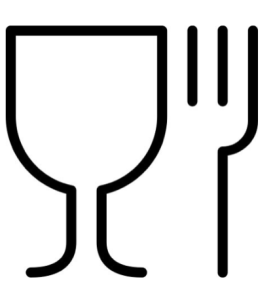 |
You will therefore find this symbol on packaging that is suitable for use in the food sector. |
Primary, secondary or tertiary packaging: what are the differences?
There are several levels of packaging, the difference being the role they play in protecting the foodstuff.
Primary packaging
The primary packaging comes into direct contact with the food. It is the first material used to wrap the food. The role of this packaging is toprotect the products, isolate the portions, facilitate handling and maintain their properties. It is an indispensable packaging, except in certain cases, such as for fruit and vegetables, among others.
Examples of primary packaging include milk cartons, glass bottles and aluminium foil around chocolate.
Secondary packaging
This type of packaging can be acombination of several primary packages, as in the case of individual bags of biscuits. In this case, the secondary packaging is the cardboard box or the bag containing the individual portions.
In another example, the plastic film containing the 6-pack of water is a secondary package. Its role is to facilitate storage, grouping and handling of the products. It also has a communication role. It is often thefirst packaging perceived by the consumer. It must therefore be attractive, and thus has a presentation objective.
Tertiary packaging
Tertiary packaging is of little concern to the consumer. It ismade up of several secondary packages, which combine several primary packages. It is the last outer layer, allowing products to be stored or handled in the warehouse and during transport. Examples of secondary packaging are film pallets, cartons containing several packages of biscuits, or even a container.
The latter type of packaging therefore has no direct contact with the foodstuffs.
Compliant food packaging can be found at RAJA
At RAJA you will finda wide range of food packaging that complies with the regulations. Reusable, recycled, recyclable or compostable: the possibilities are numerous. Here are some examples of food packaging to be found on our site:
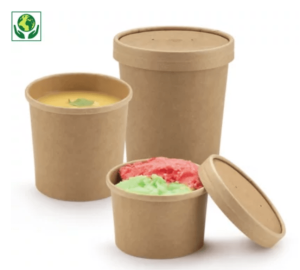 |
The RAJA brown cardboard pots with lid, for keeping food hot or cold for 15 minutes, and suitable for use in the microwave. |
 |
The sugarcane shell boxWater and fat resistant, suitable for hot filling and compostable. |
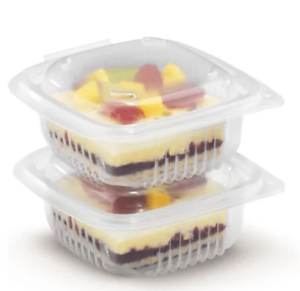 |
The Ondipack plastic food boxThe Ondipack plastic food box is waterproof and stackable, and can withstand temperatures from -20°C to 130°C. |
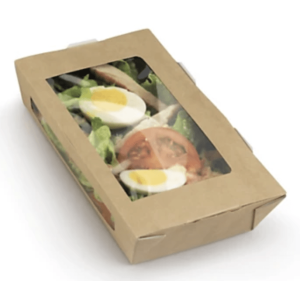 |
The cardboard box with window made of corn starch DUNIcorn starch window carton, ideal for presentation thanks to its transparent window showing the contents. |
Food safety is therefore a major concern for manufacturers and distributors of food packaging. At RAJA, most of the packaging products are perfectly suitable for food contact. Please have a look at our our catalogue or contact us for more information. You can also download our our guide to choosing your food packagingto help you succeed in your business.















